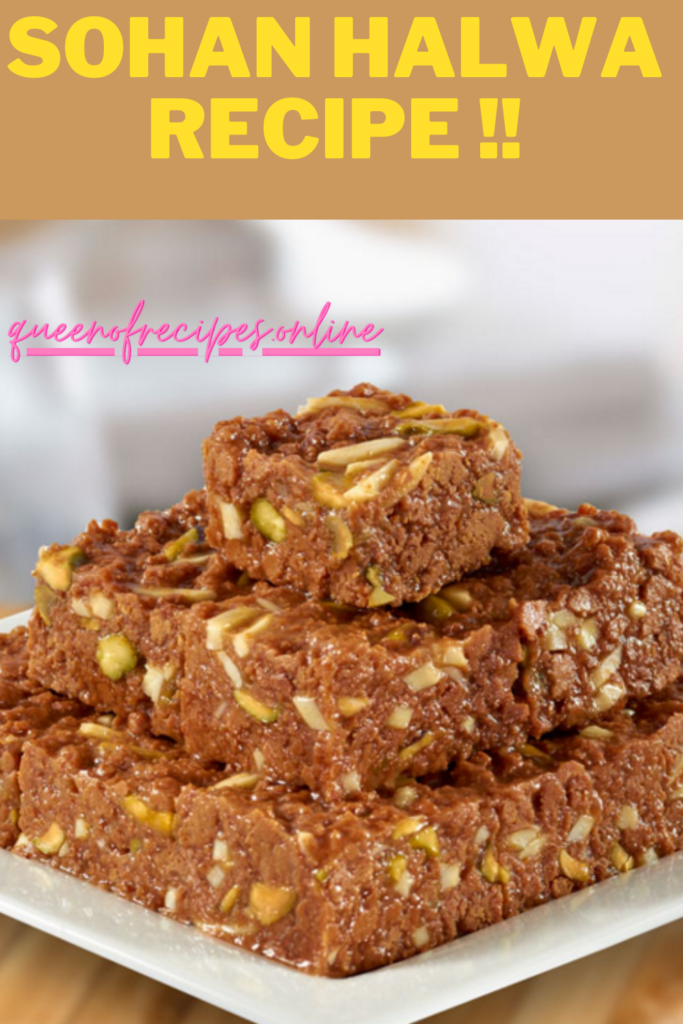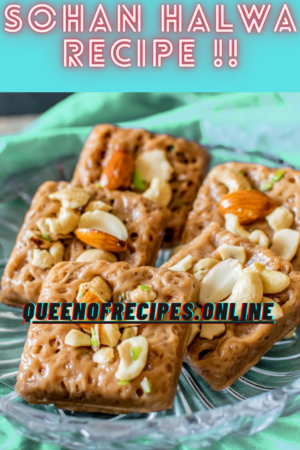Table of Contents
About us.
Sohan Halwa, a delectable and indulgent sweet treat, holds a cherished place in the realm of traditional desserts. Originating from the Indian subcontinent, this dessert boasts a rich history and cultural significance. Made from a harmonious blend of ingredients including semolina (suji), ghee, sugar, and nuts, Sohan Halwa captivates with its unique texture—both smooth and slightly chewy. Often adorned with a sprinkle of nuts and edible silver leaf, it’s a symbol of festivity and joy, enjoyed during celebrations, weddings, and auspicious occasions. The intricate preparation process and its exquisite taste make Sohan Halwa a testament to the artistry of culinary craftsmanship.
Here’s a basic recipe for making Sohan Halwa at home:
Ingredients:
- 1 cup semolina (suji)
- 1 cup sugar
- 1 cup ghee (clarified butter)
- 1 cup water
- 1/2 cup milk
- 1/4 teaspoon cardamom powder
- Chopped nuts (almonds, pistachios, cashews)
- Edible silver leaf (varak) for garnishing (optional)
Instructions:
- Preparing Syrup:
- In a saucepan, combine water and sugar. Bring it to a boil, stirring until the sugar dissolves. Simmer the syrup until it reaches a one-string consistency (a drop of syrup between your fingers should form a thin string when pulled apart).
- Roasting Semolina:
- In a separate heavy-bottomed pan, heat ghee on medium-low heat. Add semolina and roast it until it turns light golden and emits a fragrant aroma. Stir continuously to avoid burning.
- Adding Liquid:
- Gradually add milk to the roasted semolina while stirring continuously. Be cautious as the mixture may sizzle.
- Carefully add the prepared sugar syrup to the semolina-milk mixture, stirring constantly to prevent lumps.
- Cooking the Halwa:
- Continue to cook the mixture on low heat, stirring constantly. The mixture will thicken and start to leave the sides of the pan.
- Flavoring and Nuts:
- Add cardamom powder and chopped nuts to the mixture. Mix well to distribute the flavors and nuts evenly.
- Setting the Halwa:
- Transfer the halwa mixture to a greased tray or plate. Spread it evenly and smoothen the top using a spatula.
- Garnishing:
- If desired, apply edible silver leaf (varak) on top of the halwa for an elegant touch. Gently press it onto the surface.
- Cooling and Cutting:
- Allow the halwa to cool and set for a few hours or overnight. Once set, cut it into desired shapes—diamonds, squares, or rectangles.
- Serving:
- Serve the Sohan Halwa as a delightful sweet treat, either on its own or alongside other traditional desserts.
Enjoy the luxurious and melt-in-your-mouth texture of homemade Sohan Halwa, a true testament to the art of traditional Indian sweets!


Nutritional Value.
The nutritional value of Sohan Halwa can vary based on the specific recipe and serving size. Here’s an approximate breakdown for a standard serving of Sohan Halwa (100 grams):
Nutritional Values for Sohan Halwa (Per 100g Serving):
- Calories: Approximately 350-400 kcal
- Carbohydrates: Around 60-70 grams
- Protein: About 3-5 grams
- Fat: Approximately 15-20 grams
- Saturated Fat: Around 8-10 grams
- Monounsaturated Fat: Approximately 5-7 grams
- Polyunsaturated Fat: About 1-2 grams
- Fiber: Around 1-2 grams
- Sugar: Approximately 40-50 grams (mostly from added sugar)
- Sodium: Negligible
Please note that these values are approximate and can vary based on the amount of ghee, sugar, and nuts used in the recipe. The values also do not account for variations in cooking methods or additional ingredients.
Sohan Halwa is a rich and indulgent dessert that is relatively high in carbohydrates and fats due to the use of semolina and ghee. It’s often enjoyed in moderation as a treat during special occasions or celebrations. If you’re looking for a healthier version, you can consider reducing the amount of ghee and sugar used in the recipe.
Health Benefits.
While Sohan Halwa is a delightful indulgence, it also offers a few potential health benefits:
1. Energy Boost: Sohan Halwa’s main ingredient, semolina (suji), is a carbohydrate-rich source of energy that provides a quick and sustained energy boost, making it suitable for a post-activity treat.
2. Nutrient Content: Sohan Halwa contains essential nutrients from ingredients like semolina, ghee, and nuts. These include B-vitamins, healthy fats, and trace minerals that contribute to overall well-being.
3. Mood Enhancement: Enjoying Sohan Halwa occasionally can have a positive impact on mood and emotions, making it a comforting and satisfying dessert.
4. Cultural Significance: Beyond its nutritional value, Sohan Halwa holds cultural and emotional significance in many traditions and celebrations, fostering a sense of connection and joy.
5. Portion Control: Sohan Halwa’s rich and sweet nature encourages mindful consumption, promoting portion control and a balanced approach to indulgence.
6. Homemade Variation: Preparing Sohan Halwa at home allows you to control the quality of ingredients, adjust sugar levels, and choose healthier options for fats, potentially enhancing its nutritional profile.
7. Festive Treat: As a dessert enjoyed during special occasions and festivities, Sohan Halwa can contribute to a sense of celebration and social bonding.
8. Moderation: While Sohan Halwa offers certain benefits, it should be consumed in moderation due to its calorie and sugar content. Enjoy it as part of a balanced diet.
Remember that while Sohan Halwa can provide some positive attributes, it’s important to appreciate it as an occasional treat and to complement it with a variety of nutrient-rich foods in your diet for optimal health.
Tips and Tricks.
Certainly! Here are some tips and tricks to help you make a delicious batch of Sohan Halwa:
1. Patience in Roasting:
- When roasting the semolina, take your time to achieve a golden color and fragrant aroma. This step enhances the flavor of the halwa.
2. Syrup Consistency:
- Achieving the right consistency of the sugar syrup is crucial. It should form a one-string consistency, where a drop of syrup between your fingers forms a thin string.
3. Smooth Mixing:
- Gradually add the milk to the roasted semolina while stirring to prevent lumps from forming. Similarly, slowly pour the hot sugar syrup while stirring continuously to ensure a smooth mixture.
4. Constant Stirring:
- Stir the mixture constantly to prevent it from sticking to the bottom of the pan and forming lumps. This is particularly important as the halwa thickens.
5. Right Texture:
- Cook the halwa until it thickens and starts leaving the sides of the pan. It should have a smooth, yet slightly chewy texture.
6. Cardamom Fragrance:
- Use freshly ground cardamom powder for a delightful aroma and flavor that complements the sweetness of the halwa.
7. Nuts’ Crunch:
- Roast the nuts lightly before adding them to the halwa for enhanced flavor and crunchiness.
8. Grease the Tray:
- Grease the tray or plate with a little ghee before transferring the halwa mixture. This prevents sticking and makes it easier to cut later.
9. Applying Edible Silver:
- If using edible silver leaf (varak), apply it gently on the halwa’s surface using a soft brush for an elegant touch.
10. Cooling and Cutting:
- Allow the halwa to cool and set for a few hours or overnight before cutting. This ensures that it holds its shape well.
11. Storage:
- Store Sohan Halwa in an airtight container in a cool, dry place. It can stay fresh for several days.
Remember that Sohan Halwa requires attention to detail and patience, but the end result is a mouthwatering dessert that’s perfect for special occasions or as a sweet indulgence.
Serving Suggestions.
Certainly! Here are some serving suggestions to enhance your experience with Sohan Halwa:
1. Traditional Presentation: Serve Sohan Halwa on its own as a delectable dessert, presented in diamond, square, or rectangular pieces for a traditional touch.
2. Garnish with Nuts: Top the halwa pieces with a generous sprinkle of chopped nuts such as almonds, pistachios, or cashews. This adds both flavor and a delightful crunch.
3. Silver Leaf Accent: If you used edible silver leaf (varak) during preparation, its elegant shimmer adds visual appeal. Present the halwa with the silver leaf side facing up.
4. Pair with Tea or Coffee: Serve Sohan Halwa as a sweet accompaniment with a cup of tea or coffee. The contrast between the sweet halwa and the bitter warmth of the beverage can be quite pleasing.
5. Festive Occasions: Display Sohan Halwa during festive gatherings, weddings, or celebrations as a symbol of joy and tradition.
6. Boxed Gifts: Wrap individual pieces of Sohan Halwa in decorative boxes or pouches to offer as delightful homemade gifts on special occasions.
7. Dessert Platter: Create a dessert platter featuring Sohan Halwa alongside other traditional sweets like barfi, ladoo, or jalebi for a diverse and tempting spread.
8. Ice Cream Pairing: Serve a small piece of Sohan Halwa alongside a scoop of vanilla or cardamom-flavored ice cream for an interesting fusion dessert.
9. Fusion Creations: Experiment by incorporating Sohan Halwa into modern dessert creations like parfaits, tarts, or cakes for a fusion twist.
10. Decorative Elements: Use edible flowers, gold leaf, or colored sugar to decorate the serving platter for an artistic and visually appealing presentation.
Remember that the presentation of Sohan Halwa can elevate your dining experience, making it a truly delightful and memorable treat. Choose the serving style that suits the occasion and complements the rich and luxurious nature of this traditional dessert.
FAQs.
Why is my Sohan Halwa too sticky or soft?
If your Sohan Halwa turns out too sticky or soft, it could be due to insufficient cooking or improper sugar syrup consistency. Make sure to cook the mixture until it thickens and leaves the sides of the pan. Additionally, ensure that the sugar syrup reaches the correct one-string consistency before adding it to the semolina mixture. Proper cooking and achieving the right texture are essential to prevent the halwa from being overly sticky or soft.
Can I reheat Sohan Halwa?
Yes, you can reheat Sohan Halwa. Gently reheat individual pieces in the microwave using short intervals and stirring in between to maintain its texture. Alternatively, you can warm it in a non-stick pan on low heat while stirring continuously. Avoid overheating, as excessive heat might alter its consistency. Reheating allows you to enjoy the flavors and aroma of Sohan Halwa once again.
Why is Sohan Halwa sometimes referred to as Patisa or Sohan Papdi?
Sohan Halwa is sometimes referred to as “Patisa” or “Sohan Papdi” due to regional variations and cultural differences. “Patisa” is a term often used in North India and Pakistan to describe a flaky and layered sweet, which can be similar in texture to Sohan Halwa. “Sohan Papdi” is a variation of the name that emphasizes its delicate and papery texture. These names might have originated from the varying techniques, ingredients, or textures used in different regions, leading to distinct regional names for essentially the same or similar sweet delicacy.

